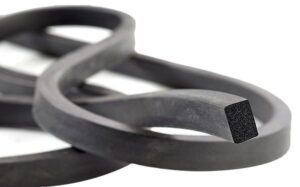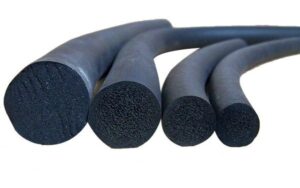In the world of rubber sealing and insulation materials, foam rubber and sponge rubber are two widely used materials that often confuse customers. Although similar in appearance, their internal structures, properties, and applications vary significantly. Understanding the difference between foam and sponge rubber can help you choose the right material for your sealing, cushioning, or insulation needs.
🔍 What Is Foam Rubber?
Foam rubber typically refers to closed-cell rubber materials, in which air or gas is trapped in isolated pockets. This structure makes foam rubber lightweight, waterproof, and ideal for sealing applications where air and water tightness is required.

Key Features:
- Closed-cell structure
- Excellent sealing and insulation
- Water, dust, and air resistant
- Ideal for doors, windows, HVAC, and automotive seals
🌬️ What Is Sponge Rubber?
Sponge rubber refers to open-cell rubber, where cells are interconnected. This allows it to compress easily, making it ideal for shock absorption, vibration damping, and moisture absorption.

Key Features:
- Open-cell structure
- High compressibility
- Good cushioning and shock absorption
- Absorbs moisture, useful in damp environments
🧪 Common Types of Foam and Sponge Rubber
Here are the most commonly used types of foam and sponge rubber, each with unique properties and typical applications:
✅ EPDM Foam & EPDM Sponge
EPDM (Ethylene Propylene Diene Monomer) is known for weather, ozone, and UV resistance.
- EPDM Foam: Ideal for weather seals, HVAC gaskets, and automotive strips
- EPDM Sponge: Offers soft cushioning, used in enclosures, electrical panels, and equipment housings
✅ NBR Foam & NBR Sponge
NBR (Nitrile Butadiene Rubber) is excellent for oil and fuel resistance.
- NBR Foam: Used in industrial gaskets, fuel system seals, and vibration insulation
- NBR Sponge: Applied in padding, shock absorption, and oil-resistant sealing
✅ Neoprene Foam & Neoprene Sponge
Neoprene is durable and resists aging and abrasion.
- Neoprene Foam: Weather-resistant, commonly used in outdoor sealing applications
- Neoprene Sponge: Great for vibration control in marine and construction applications
✅ Silicone Foam & Silicone Sponge
Silicone offers outstanding high-temperature resistance and flexibility.
- Silicone Foam: Used in aerospace, automotive, and medical equipment
- Silicone Sponge: Adapts to uneven surfaces, ideal for thermal insulation and gasket sealing
📊 Foam vs Sponge Rubber: Key Differences
| Feature | Foam Rubber (Closed-Cell) | Sponge Rubber (Open-Cell) |
| Cell Structure | Closed-cell | Open-cell |
| Water Absorption | Low | High |
| Compressibility | Moderate | High |
| Sealing Performance | Excellent | Moderate |
| Weight | Lightweight | Slightly heavier |
| Shock Absorption | Moderate | Excellent |
🎯 Applications of Foam and Sponge Rubber
- Automotive Weatherstrips
- HVAC Gaskets and Duct Seals
- Electrical Enclosures and Cabinets
- Industrial Machinery Padding
- Marine Equipment and Fendering
- Construction Expansion Joints
- Protective Packaging
🏭 Why Choose Okin Rubber?
At Okin, we specialize in the manufacture of custom foam and sponge rubber products, including extruded profiles and molded parts. With 21 advanced extrusion lines, including co-extrusion and foam extrusion capabilities, we deliver high-performance EPDM, NBR, Neoprene, and Silicone rubber materials that meet demanding industrial requirements.
We proudly serve global markets with competitive pricing, high precision, and flexible customization. Whether you’re looking for closed-cell foam for tight sealing or open-cell sponge for cushioning, Okin Rubber offers reliable solutions tailored to your project.
✅ Conclusion
Foam rubber is perfect for applications that demand sealing, insulation, and water resistance, while sponge rubber excels in shock absorption, flexibility, and moisture handling. Each material serves a specific purpose. By understanding the differences in structure and performance, you can make smarter decisions for your application.
Choosing the right material will enhance your product’s durability, efficiency, and user experience. If you’re not sure which one to choose, our experts at Okin Rubber are here to help.
Follow us on LinkedIn, Facebook, and Instagram for more industry insights and updates!
